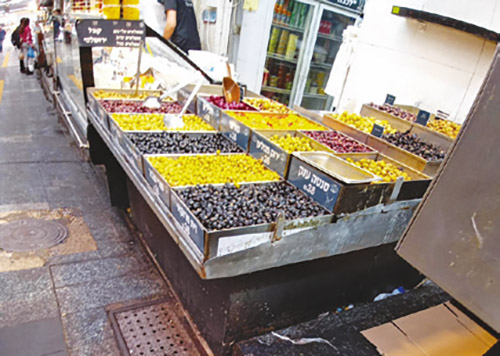
The historical information in this article is based on Nirit Shalev-Califa’s book נחלאות בלב העיר published by Yad Yitzchak ben Tzvi.
The author cannot endorse the kashrut of any of the stores mentioned or photographed in this article.
In today’s busy world, how often do we actually step into a store? So many of our purchases are made online from the comfort of our homes. In downtown Yerushalayim. however, we can once again return to the market of years gone by. A bustling center of store owners calling out their wares and purchasers hondling over the price. Welcome to Machane Yehuda!

The early days of the shuk (marketplaces) date back to the beginning of the 20th century. There were a few Jewish neighborhoods already established outside the walls of the old city. This encouraged the Arab Falachin farmers to bring their wares and produce to an empty field outside of the Beit Yaakov and Machane Yehuda neighborhoods. The Jewish settlers no longer had to travel all the way to the old city in order to purchase their needs. The Falachin, mostly coming from the village of Lifta, did not need to carry their wares all the way to the old city in order to sell them. The arrangement was beneficial for all and thus began the shuk in the empty field owned by the Jewish Volero family. The Ottoman authorities, who ruled the Land of Israel at the time, did not pay much attention to what was going on in the shuk. Its functioning was based on the cooperation and good will between the buyers and sellers.
Things changed in 1917 when the British Mandate began in the Land of Israel after World War 1. The British were appalled by the lack of organization and sanitary conditions in the open market and made plans to renovate the shuk. But before they could do so, the nature of the entire marketplace changed.
The Arab riots of 1920-21 and 1929 created a huge rift between the Jewish and Arab populations. Jews no longer felt safe doing any shopping in the Arab markets of the Old City. Additionally, the sellers of the Machane Yehuda market also changed. Instead of the Arab Falachin, new Jewish immigrants and settlers of the new neighborhoods brought their wares and produce to sell in the market.
At the same time, the British did not relent from their insistence that the market be more organized and sanitary. Laws mandated that goods be sold from proper stands and shops, not just placed on the floor. The British police would come and enforce the law by destroying all stands that did not conform to regulation. The situation was difficult for the poor Jews of Yerushalayim who were just trying to earn a little bit to provide for their families. A group of Jewish merchants got together and took out loans in order to construct proper stands that conformed to the law. At the same time, poorer peddlers would still sell their wares nearby at cheaper prices since they didn’t have the debt of storefront construction. This led to conflict between the store owners and the peddlers, who turned to the Jewish council of Yerushalayim, the Va’ad Ha’ir.

With the help of the Agudat Halva’ah V’chischun, a Jewish organization formed in Yerushalayim to financially aid the Jewish community of Yerushalayim after the devastating poverty of World War 1, funds were collected and plans were made to construct a proper marketplace that would also satisfy the requirements of the British. Construction began in 1930. It was here that the first public bathroom was built in Yerushalayim.
Since then, the Machane Yehuda market has grown and blossomed. It displays a microcosm of the varying populations of the State of Israel. Diverse immigrant groups display their ethnic culture and foods for the consumer to enjoy. Each store has its own story, its own heritage, its own legacy.
I was privileged to speak with Binyamin from the Rozmarin spice shop, who shared his family’s story. His Sabbah Shalom made aliyah from Iran and opened a spice store in the Bucharim market. His grandchildren moved to the Machane Yehuda Market about 20 years ago. They still make their own mixtures and have spices that are gluten-free and without MSG.
Nearby is the Mamlechet HaHalva stand. I’ll translate that as the Halva Empire! The store displays many flavors of halva in large “cakes” that can be tasted by the shopper. The worker explained to me that this store began in Morocco in 1947. The owners then moved to Israel, where they opened a store in the Old City. In 2003, they moved to the Machane Yehuda market. Their halva is still handmade, and the sesame is ground with a millstone. Their product is 80% sesame, which is unique for contemporary halva. They offer 101 different flavors of halva!

Machane Yehuda is bursting with exciting stories, tastes and sounds. I invite you to explore this incredible part of Yerushalayim!
Hava Preil is an enthusiastic licensed israeli tour guide. She grew up on the Upper West Side of Manhattan and holds an MA in Judaic studies. Hava has developed and taught accredited courses in Tanach and Jewish ethics for Naaleh/Woodmont College and Cybersem. She currently lives in Givat Ze’ev, Israel with her family. Hava can be reached at IL:054-844-1579, USA: 845-391-0438 or at Havapreil@gmail.com










